Table of Contents
ToggleUganda National Immunization Schedule
Uganda National Expanded Program on Immunization (UNEPI), which was officially launched in October, 1993, was formed to address issues of low immunization coverage; use of non-potent vaccines; inadequate managerial and service provider skills; limited or no community participation and lack of regular monitoring and periodic evaluation of the program. The re-launching of the program in 1997 marked a great improvement in the routine immunization coverage and reduction in the incidence of Vaccine Preventable Diseases (VPD) like measles.
UNEPI has a plan it follows to administer vaccines. This plan clearly shows the vaccines that are given, the dose, time interval between doses, and the site of administration. This is called the national immunization schedule. This standard plan provides a guide to all health workers in the country involved in immobilization. The immunization schedule varies from country to country and can change from time to time depending on scientific discoveries.
UNEPI Strategic Objectives
- Formulate policy, standards and guidelines.
- Ensure availability of potent and effective vaccines.
- Increase access and demand for immunization services.
- Build EPI technical and management capacity at all levels.
- Monitor disease trends and program performance.
Strategies
- Provision of routine immunization through the national health delivery system.
- Provide and maintain an effective cold chain and logistics system at all levels.
- Improve communication skills among health workers to enable them to communicate effectively to parents, guardians, caretakers, politicians, policy makers, other leaders, and communities.
- Strengthen technical and administrative support supervision.
- Provide technical guidance to pre-service and on-job training.
- Strengthen partnership with other child promoting programs, agencies, Non-Government organizations, civil society organizations, religious organizations, and the private sector in service delivery and social mobilization.
- Enhance advocacy, social mobilization, and public education.
- Promote and ensure safe injection practices in immunization services.
- Strengthen and maintain a surveillance system of vaccine-preventable diseases using the Integrated Disease Surveillance Response (IDSR) approach.
- Promote monitoring, investigation, and management of adverse events following immunization (AEFI).
- Carry out supplemental immunization activities against targeted diseases.
- Adopt and use internationally recommended approaches and guidelines such as Reaching Every District/Reaching Every Child (RED/REC) that are relevant to Uganda.
- Implement other innovative strategies that will benefit the hard-to-reach population.
- Strengthen measles control, maternal and neonatal tetanus elimination, and polio eradication measures.
Roles of Different Levels of Immunization Service Delivery
Central Level (UNEPI)
- Policy, standards, and guidelines formulation.
- Technical supportive supervision to districts.
- Strategic planning, budgeting, and resource mobilization.
- Technical backup-cold chain, surveillance.
- Capacity building.
- Monitoring and evaluation.
Central (National Medical Stores)
- Procurement of vaccines, injection materials, and gas.
District Level
- Responsible for the implementation of Government policy.
- Forecasting, ordering, and storing of vaccines and other UNEPI logistics.
- Distribution of vaccines, gas, injection materials, and other UNEPI logistics to lower-level facilities with fridges (private and public).
- Cold chain maintenance and repair.
- Support supervision and on-job training.
- Monitoring for action, e.g., monitoring coverage, drop-out rate, and vaccine wastage.
- Feedback to HSD/HFs and the community on UNEPI performance.
- Active search and surveillance for AFP, NNT, and measles cases.
Health Facility Level
- Provide immunization services.
- Counseling/health education to parents/caretakers.
- Plan and conduct outreaches.
- Screen for immunization status to reduce missed opportunities.
- Estimate, order, and store vaccines and other logistics.
- Maintain fridge temperature within the recommended ranges (+2°C – +8°C).
- Defrost the fridge.
- Fill and balance/update the vaccine and injection materials control book daily.
- Monitor vaccine wastage, coverage, and dropout rate.
- Home visiting and tracking dropout/defaulters.
- Timely and complete reporting.
- Give feedback to the community on EPI performance.
- Provide cost-effective public announcements on EPI.
- Work with community mobilizers.
- Ensure injection safety and waste management.
Roles of Community (Village Health Team Members-VHT, Parents/Caregivers)
- Taking children for immunization and ensure completing the immunization schedule.
- Planning immunization services (site, day, and time of routine immunization outreach).
- Monitoring the performance of immunization services (functionality of outreaches).
- Mobilizing other parents for immunization.
- Safe storage of immunization cards and presenting them whenever they visit a health facility.
Vaccines Used in Immunization Schedule
BCG (Bacillus Calmette-Guerin) Vaccine
This is a live attenuated (weakened) bacterial vaccine. It is used in the immunization program to protect the child against tuberculosis. BCG is given in a single dose at birth or first contact. The vaccine is very sensitive to light and loses much of its potency when exposed to light. It is given by injecting the child in the skin (intradermally) at the right upper arm. The amount of 0.05 ml is recommended for children up to eleven (11) months of age, and 0.1 ml for children after eleven years.
Polio Vaccine
Polio vaccine is a live attenuated virus vaccine used in the immunization program to protect the child against poliomyelitis. The Sabin type is given orally (by mouth) in Uganda. Some countries use another type called Salk vaccine, which is given by injection.
Oral polio vaccine is given four times beginning
- at birth (polio 0);
- at 6 weeks polio 1;
- at 10 weeks polio 2, and
- at 14 weeks polio 3 respectively.
2 drops in the mouth are recommended for each dose. It should be noted that booster doses are sometimes given to all children below five years of age in the entire country regardless of immunization status. This is done during national immunization days (NIDs), whose primary objective is to eradicate poliomyelitis. It is nice to remember that polio vaccine is made up of three polio viruses, and the oral polio vaccine is given four times to enable each of three viruses to stimulate the production of antibodies.
Pentavalent Vaccine
Pentavalent vaccine has 5 vaccines which include DPT and Hep.b & Hib. The DPT vaccine is commonly referred to as a triple vaccine because it is used to prevent three diseases, namely diphtheria, pertussis, and tetanus. The diphtheria and tetanus parts of the vaccine are made from the respective toxins, while the pertussis vaccine is made of killed bacterial antigen. It has become necessary to add hepatitis B and haemophylus influenza type b vaccines to DPT to form what is now known as the Pentavalent vaccine (five vaccines).
These are given three times because they do not stimulate the body to produce antibodies as well as the live attenuated vaccines. When the second and the third dose are given, the body’s memory of the earlier dose quickly leads to the production of more antibodies. The Pentavalent vaccine is given by injecting the child intramuscularly (in the muscle) at the left upper thigh.
It is given three times beginning
- at 6 weeks, at 10 weeks, and at 14 weeks, respectively.
- A dose of 0.5 ml is recommended each time given.
Tetanus Toxoid Vaccine
This is a toxoid vaccine used in the immunization program to prevent children against neonatal tetanus. UNEPI targets all women of childbearing age (15-49 years) and pregnant mothers for tetanus toxoid (TT) vaccination. It is better and safe to give two doses of TT vaccine to any pregnant woman if you are not sure she has had TT in a previous pregnancy. The aim is to use the TT vaccine to provide passive immunity for unborn babies, through the transfer of the mother’s antibodies. This type of immunity reduces with time and is normally boosted by giving the child Pentavalent vaccines at 6 weeks after birth.
Pneumococcal Conjugate Vaccine (PCV 10)
PCV 10 consists of sugars (polysaccharides) from the capsule of the bacterium streptococcus pneumonia, which are conjugated to a carrier protein.
The PCV 10 contains serotypes 1, 4, 5, 6B, 7F, 9V, 14, 18C, 19F, and 23F. It is highly effective and protects children younger than 2 years of age against severe forms of pneumococcal disease, such as meningitis, pneumonia, and bacteremia. It will not protect against these conditions if they are caused by agents other than pneumococcus or pneumococcal serotypes not present in the vaccine.
The World Health Organization and Ministry of Health recommend that infants be given three doses of PCV vaccine,
- at 6 weeks, 10 weeks, and 14 weeks.
- PCV should be integrated with DPT-HepB-Hib vaccination.
Rotavirus Vaccine
Rotavirus vaccine is a vaccine used to protect against rotavirus infections. These viruses are the leading cause of severe diarrhea among young children. The vaccines are safe. This includes their use in people with HIV/AIDS. The vaccines are made from weakened rotavirus.
The World Health Organization recommends the first dose of vaccine be given right after 6 weeks of age. Two or three doses more than a month apart should be given, depending on the vaccine administered. The vaccine is not recommended for use in children over two years of age.
Administration of Vaccines
Immunization coverage should be high to reduce disease transmission. As health workers, we should aim to achieve immunization coverage of over 80%. All children should be immunized at every opportunity. There is no contraindication for immunization. If immunization is done daily, this improves immunization coverage. Children with minor illnesses should be immunized. The misconception that sick children should not be immunized should be discarded. Very sick children admitted to the hospital should be immunized on discharge. Malnourished children should also be immunized. The danger of vaccine of any given type to the malnourished child is much less than the infection itself. For children with HIV/AIDS, BCG can spread rapidly and thus should be treated as an opportunistic infection.
Administering Vaccines
Vaccines used in the immunization program are in different forms. Some vaccines are in powder form and must be dissolved in the diluent supplied with them, while others come in liquid form and will not need a diluent. There is a need to prepare the vaccine before immunization.
Preparing Polio Vaccine
To prepare this vaccine the following should be done: If a dropper is separate, attach it securely to the vial (bottle). Keep polio vaccine shaded from sunlight during the immunization session. Place the vial on a frozen icepack or place it in the sponge hole placed at the mouth of the vaccine carrier, which is provided for this purpose to maintain the temperature.
Preparing BCG and Measles Vaccines
The following should be done: Use the diluent provided for each vaccine. The diluent should be cold, +4°C – +8°C. Use different 9 ml syringes for mixing measles and BCG vaccines. Draw up the full required amount of the diluent provided as per instruction on the vial. Draw and expel mixture back into the bottle three times or until the vaccine is mixed. Do not shake the vial. BCG and measles vaccines should be placed on a frozen icepack or use the sponge in the vaccine carrier for maintaining the correct temperature. Draw 0.5 ml of measles vaccine (recommended dosage). Draw 0.05 ml of BCG vaccine for babies up to 11 months old and 0.1 ml for babies above 11 months of age (recommended dose).
Preparing DPT and TT
DPT and TT come in liquid form. You will not need to dissolve or mix them. Remove the metal top from the vial. Draw 0.5 ml into the sterile syringe. Remove bubbles. Keep the vaccine shaded from the light.
Preparing PCV 10
Ensure availability of a clean vaccine carrier and a sponge. The vaccine carrier should be able to close tightly. Condition icepacks prior to packing vaccines in a vaccine carrier to prevent freezing of PCV, TT, and DPT-Hep B-Hib. On a table with a plastic sheet: – Vaccines, diluent, and droppers – Thermometer – Cotton swab in a clean container – Clean water in a clean container for cleaning injection sites – A tin of vitamin A and a pair of scissors – AD syringe and needles – Child health cards – Child register
Important Points to Remember
- Never take two vials of the same vaccine out of the vaccine carrier at the same time.
- Do not mix vaccines until mothers and children are present.
- Mix one vial of a particular vaccine at a time.
- Keep opened vials of polio, measles, and BCG vaccines on a frozen icepack or use the sponge in the vaccine carrier. Their temperature must be carefully maintained.
- Do not keep vials of DPT and TT vaccines directly on the frozen icepack.
- Open the vaccine carrier when necessary.
- NEVER SHAKE VACCINE VIALS!!!
- After preparing vaccines, the next step is to administer them. Before administering vaccines, you should always remember the following important points:
- Use one sterile syringe and needle per vaccine (antigen) per child or mother.
- Avoid holding loaded syringes in your hand for long to avoid exposing the vaccine to heat or direct sunlight.
- Inform each parent what type of vaccine you are giving the child, the possible reactions to it, what to do about the reactions, and when to bring the child back for more immunization.
- Listen to parents and encourage questions.
- Remove any child’s clothes that are in your way when vaccinating.
- During immunization, ask the mother to hold the child firmly to restrict their movement during immunization.
- Administer the vaccine.
- Give specific health information about each vaccine.
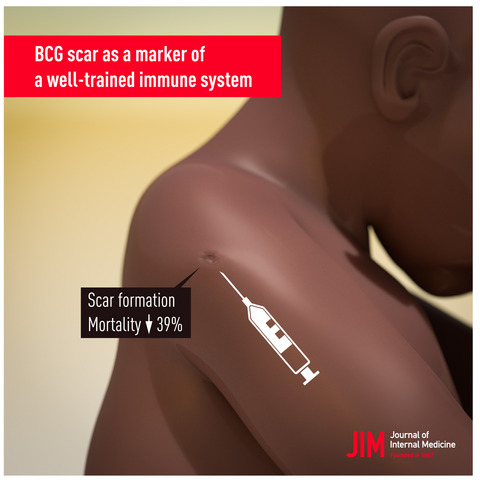
Administering BCG
- Clean the skin with cotton wool soaked in clean water and let it dry.
- Hold the middle of the child’s upper right arm firmly with your left hand.
- Hold the syringe by the barrel with the millimeter scale upward and the needle pointing in the direction of the child’s shoulder. Do not touch the plunger.
- Point the needle against the skin, barrel turned up about 3 cm above the thumb. Gently insert its tip into the upper layer of the skin (intradermally).
- Make sure that the needle is in the skin (intradermally) and not under the skin. If the needle goes under the skin, take it out and insert it again. If you bend the needle, replace it with another sterile one.
- Holding the barrel with your index and middle finger, put your thumb on the plunger.
- Holding the syringe flat (parallel to the surface of the skin), inject the vaccine intradermally.
- If the vaccine is injected correctly into the skin, a wheal, with the surface pitted like an orange peel, will appear at the injection site. An indication that the vaccine has been injected incorrectly is that the plunger will move much more easily when the needle is injected under the skin than when it is injected in the skin. If there is no local reaction, re-immunize the child.
- Give the mother health information about BCG, i.e.
- In 7-9 days, a small sore will appear at the site where the injection was given.
- The sore might ooze a bit and will last for 6-8 weeks.
- Keep the baby’s arm clean with soap and water.
- Do not put dressing or medicine on the sore.
- The sore will not hurt and it will heal by itself.
- Change the syringe and needle after each vaccine and each child.
- Fill in the immunization tally sheet in the BCG section.
- Administer the next vaccine.

Administering DPT Vaccine
- Ask the mother to hold the child across her laps so that the front of the child’s thigh is facing upwards. Then ask her to hold the child’s legs from moving.
- Clean the site to be injected with a cotton swab moistened in clean water and let it dry.
- Place your thumb and index finger on each side of the place you intend to inject. Stretch the skin slightly.
- Quickly push the needle deeply into the muscle (intramuscular). Pull the plunger back; if there is blood in the syringe, withdraw the needle and discard the vaccine. Obtain a sterile syringe with a needle and new vaccine.
- If no blood appears in the syringe, inject 0.5 ml of vaccine.
- Withdraw the needle.
- Rub the injection spot quickly with a clean piece of cotton swab.
- Give health advice about DPT. Tell the mother that:
- DPT may cause some tenderness at the site. The tenderness will go away after a few days.
- DPT may cause fever but it will subside in 24 hours.
- Fill the immunization tally sheet appropriately.
- Use another needle and syringe to vaccinate another child.
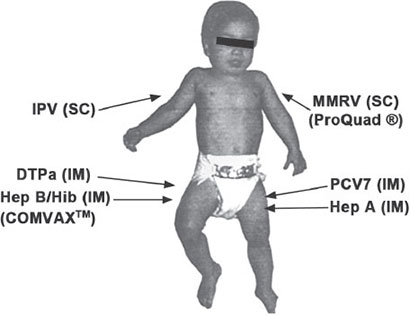
Administering PCV Vaccine
- Explain to the mother that the child is going to be given two types of vaccines in the form of injections. One will be given in the right and the other in the left thigh.
- Explain to the parent the disease prevented by the vaccine, the number of doses in order to achieve the protection, and reassure her that there is no danger in giving two injections in one visit.
- Explain to the mother the likely side effects and how to manage them, then wash hands with soap and water, drip dry.
- Open the vaccine carrier and pick one vial of PCV and quickly check the expiry date and status of the vial.
- Observe the vial content for unusual appearance and particles. If either is observed, the vial must be discarded.
- Shake the vaccine vial gently to obtain a uniform solution.
- Draw 0.5 ml of the vaccine from the vial using an AD syringe and return the partially used vial in a sponge in a vaccine carrier.
- Instruct the mother on how to hold the child for vaccine administration.
- Clean the right upper outer thigh with a swab soaked in water and administer the vaccine intramuscularly.
- Press the injection site firmly for a few seconds. Do not massage.
- Dispose of the used syringe and needle immediately into the safety box.
- Do not put swabs in the safety box.
- Do not recap the needle.
- If a vial is opened for one child and another child is not immediately available to be vaccinated with the remaining vaccine dose in the vial, write on the vial the time it was opened and ensure that the vial is kept cool in the sponge pad and away from any potential contamination for 6 hours.
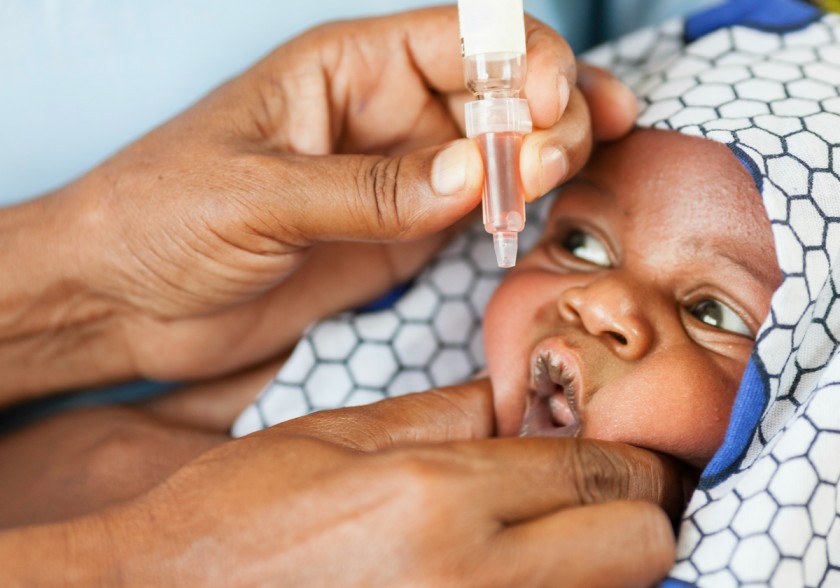
Administering Oral Polio
- Ask the child’s mother whether the child has diarrhea. If yes, note this on the child’s card and tell the mother that this dose of polio needs to be repeated after one month. This child with diarrhea should have a total of 4-9 doses of polio vaccine depending on whether the child got polio 0 or not.
- Use the dropper or device supplied with the vaccine.
- If the child will not open the mouth, gently squeeze his/her cheeks to open his mouth.
- Put 2 drops of vaccine on the child’s tongue.
- Fill in the immunization tally sheet appropriately.
- Note that a very child below 9 years of age should receive an extra 2 doses of oral polio vaccine (OPV) each year during national immunization days (NIDs), whether she/he was immunized before or not.
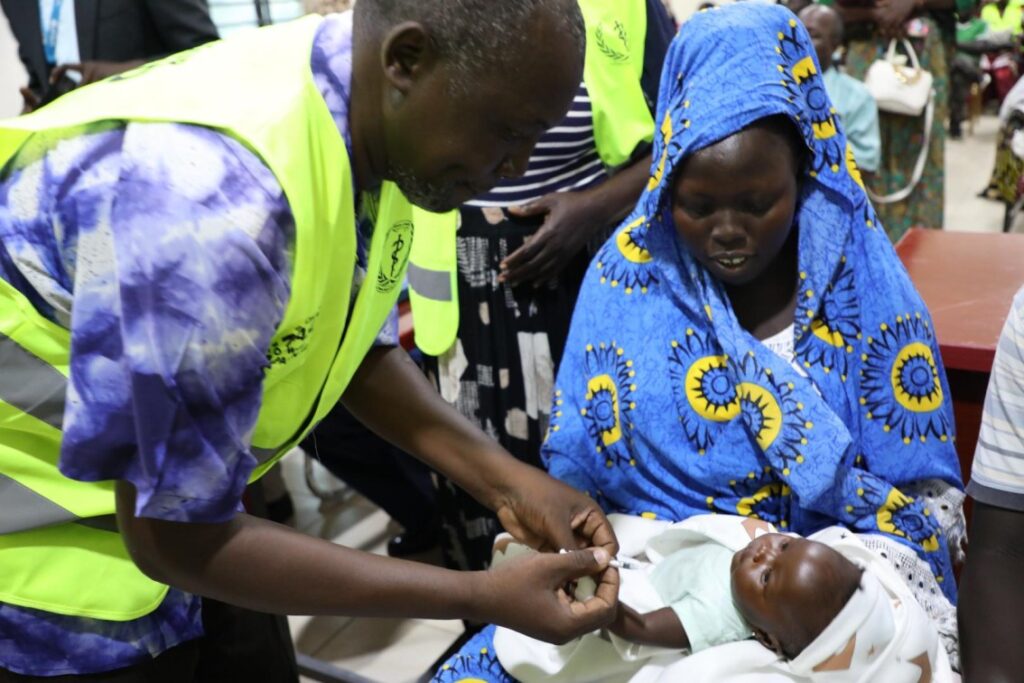
Administering Measles
- Use a sterile syringe and needle for each injection. Draw 0.5 ml dose of mixed measles vaccine.
- Ask the mother to expose the child’s left outer upper arm and hold the child firmly to restrict their movement.
- Clean the injection site with a cotton swab soaked in clean water and let it dry.
- With the fingers of one hand, pinch the skin on the outer side of the upper arm.
- Hold the syringe at an acute angle to the child’s arm. Inject the vaccine subcutaneously.
- To avoid injecting the vaccine into a vein, withdraw the plunger slightly before injecting the vaccine. Never give the vaccine if blood is seen in the syringe.
- Press the plunger gently, inject 0.5 ml of vaccine.
- Withdraw the needle. If a drop of blood appears at the injection site, ask the mother to wipe it away with a piece of cotton wool.
- If blood is drawn back in the syringe, the vaccine should not be given. Use another needle and syringe to obtain new vaccine.
- Record the immunization in the immunization tally sheet.

Administering TT Vaccine
- Pregnant mothers should be given two doses of TT vaccine (0.5 ml) a month apart. However, if it is not possible to establish whether the mother had previously been immunized with TT or whether the mother was a default from a previous dose, two doses should be given a month apart.
- Use a sterile syringe and needle for each injection.
- Clean the thigh with cotton wool moistened in clean water.
- Hold the thigh muscle between your thumb and forefinger.
- With your other hand, inject the vaccine intramuscularly.
- Withdraw the needle.
- Discard the needle and syringe into a safety box. Ensure you do not put swabs in the safety box. Safety boxes are collected and burned.
- Fill the immunization tally sheet.
Equipment/Logistics Needed for Safe Vaccination
- Safety box
- Vaccine carrier with 8-10 vials in a sponge pad
- Ice packs (frozen water bottles)
- Vaccine vials
- Diluents in a vaccine carrier
- Bottles of clean drinking water for washing hands and cleaning injection sites
- Swabs
- Vaccine carrier with sponge pad
- Cold boxes, ice packs
- Sharps container
- Syringe and needles
- AD syringe and needles
Post-Vaccination Counselling
- Reassure parents of the vaccine safety and the minor side effects such as swelling and redness at the site, slight fever, or soreness at the site.
- Encourage parents to bring back a child that developed a fever after vaccination.
- Offer health education (nutrition, hygiene, breastfeeding).
- Ask mothers if they have any concerns, and answer questions.
- Inform mothers about the next visit to the health facility.
- Give vitamin A to children 6-11 months, and 12-59 months. If the child is 6 months of age, immunize her with measles as the first dose of measles vaccine. Instruct the mother that the second dose of measles vaccine will be given at 18 months.
Record Keeping
All vaccines administered must be recorded in a tally sheet to monitor the performance of the program. Record keeping is mandatory. When mothers and children are not present to receive immunization, it becomes necessary to record vaccines that have been administered. Immunization records are used to check the child’s immunization status and the number of vaccines that need to be given at a particular age or when a child’s age is not known. In case of incomplete immunization, an entry must be made in the immunization register and/or the child’s health card. Record any reactions in the health card.

Immunization Register
- At the top, there should be the name of the health facility. This name should match the one on the health unit or facility.
- The first line should include the heading “immunization register”.
- Include in this register the names of children only (males and females) and not those of their parents. This is very important.
- Enter the name of the health facility at the top. Enter the mother’s card (or medical file) number and name of the child. In the column on the right, there should be the date the child was born.
- Enter the number of BCG vaccine the child received and the date. Enter BCG vaccine as zero in case the child did not receive it.
- Enter the number of polio vaccine doses and dates (0, 1, 2, and 3). Record zero (0) in case the child did not receive polio vaccine.
- Enter the number of DPT and the date given. Record zero in case the child did not receive the vaccine.
- Enter the number of measles vaccines given to the child and the date.
- In case a child received OPV or a dose of Vitamin A, do not record it in the immunization register but only in the child’s card.
Health Cards
There should be one child’s health card per child. The card should have the following information: child’s name, mother’s name, date of birth, village of origin, and health unit where she is regularly vaccinated. The health card should also contain information on vaccines and their doses (including vaccine cards for Pentavalent and measles) and other health information such as vitamin A. In the case of measles vaccine, measles vaccine should only be written on the card after the child receives the vaccine. Vitamin A capsules should only be marked on the card after they are administered. Ensure that the child’s card is up-to-date before vaccinating the child.

The Refrigerator
The refrigerator is the main immunization equipment used to store vaccines. Refrigerators should be properly maintained and in good working condition at all times. All refrigerators should be maintained at temperatures between +2°C – +8°C.
Types of Refrigerators Used in Immunization
- Solar direct drive (SDD) vaccine refrigerator.
- Gas refrigerators (Kerosene or paraffin) vaccine refrigerator.
- Electric vaccine refrigerator (Abso Type).
- Refrigerator 24 or 40 liters.
The refrigerator should be able to freeze ice packs. These ice packs are used to keep the vaccines cool in case the refrigerator breaks down or during vaccination outreaches. Icepacks inside the vaccine carrier are called Conditioned Icepacks
Preventive Maintenance and Repair of Refrigerators
All refrigerators should be serviced and maintained every 3 months. The 24 and 40-liter refrigerators are serviced every 3 months. Solar direct drive refrigerators (SDDs) are serviced and maintained by a team of technicians from the central level of the Ministry of Health (MoH). During maintenance, the following activities are done:
- All refrigerators are cleaned.
- The thermostat setting is checked.
- The defrosting system is checked.
- The cooling system is checked.
- The compressor is checked and cleaned.
- The electrical connection is checked.
Managing Adverse Events
In addition to managing the usual side effects of immunization, it is important to respond appropriately to any adverse events following immunization (AEFI).
An AEFI is any untoward medical occurrence which follows immunization and does not necessarily have a causal relationship with the use of the vaccine. The following steps are recommended for managing AEFI.
Fever
- Parents should be advised to give the child paracetamol (acetaminophen) in the appropriate dose for weight to lower the fever.
- Do not give aspirin or any other drugs that contain aspirin to children.
- Encourage mothers to give the child plenty of fluids.
Swelling or Redness at the Site of Injection
- Do not give the child any drug for the swelling or redness.
Swelling of the Limbs or Face, or Difficulty in Breathing
- Do not give any drug.
- Seek medical attention as soon as possible.
Loss of Weight, Generalized Body Swelling, Poor Feeding, or Coughing
- These are symptoms of malnutrition.
- These are unlikely to be a side effect of vaccination.
- Refer to the nearest health facility for treatment and monitoring.
- You must inform the child’s health worker when the child receives a second dose of vaccine so that a different child’s card will be given to the mother.
Diarrhea
- Diarrhea is most likely not related to vaccination.
- Make sure that the child receives oral rehydration solution (ORS) or other appropriate fluids, as recommended.

Conducting Mass Vaccination Campaigns
Mass vaccination campaigns may be conducted on national immunization days (NIDs) or during outbreak responses. Mass vaccination campaigns often target a specific age group and can be carried out in various settings, such as schools, community centers, and healthcare facilities. To effectively conduct mass vaccination campaigns, the following steps should be considered:
Planning and Training: Start by planning the campaign, identifying target populations, and training healthcare workers on vaccination procedures. Ensure there is adequate vaccine supply and cold chain equipment.
Community Mobilization: Inform communities well in advance about the campaign, its purpose, and the date of the event. Use various communication channels to raise awareness and address concerns.
Logistics: Make sure you have all the necessary equipment, vaccines, and logistics in place, including syringes, needles, cold chain equipment, and safety boxes.
Safety Measures: Implement safety measures, such as infection control, safe disposal of waste, and adequate crowd control at vaccination sites.
Vaccination Site Setup: Organize vaccination sites efficiently, ensuring a clear flow of people from registration to vaccination to post-vaccination observation.
Vaccine Administration: Follow the standard procedures for vaccine administration, ensuring each vaccine is administered with a sterile syringe and needle.
Monitoring and Reporting: Monitor the campaign’s progress and track the number of vaccines administered. Ensure that adverse events following immunization (AEFI) are reported and managed promptly.
Documentation: Maintain detailed records of all vaccines administered during the campaign, including a tally of doses given and vaccine wastage.
Post-Campaign Evaluation: Evaluate the campaign’s success, identify areas for improvement, and gather feedback from healthcare workers, communities, and relevant stakeholders.
Follow-Up and Sustained Immunization: After the campaign, continue routine immunization services and ensure that children receive follow-up doses as needed. Encourage parents and caregivers to complete the vaccination schedule.

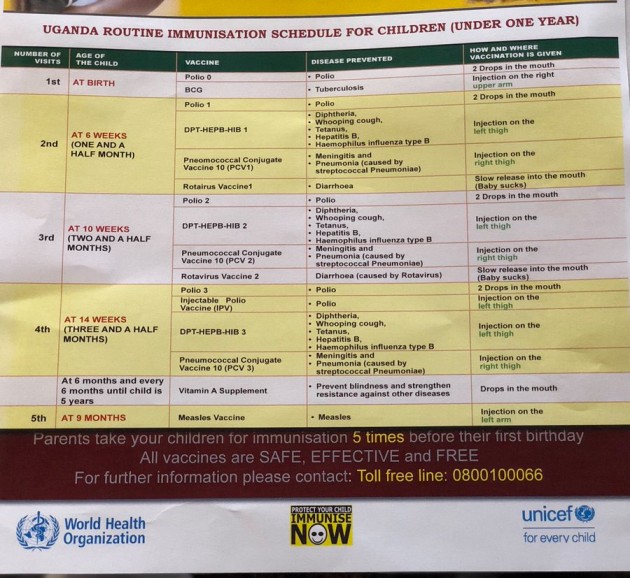
Thanks alot UNEPI for the update ,as finalist in medical school King Ceasor University I’m very grateful for new and great knowledge I have obtained from reading this schedule.Hopiing to continue following your updates in order to get more knowledge to serve the nation Thanks
GREAT INSIGTS LEARNT
ALLOW US PERMISSION FOR OFFLINE READING
THE ARTICLE IS VERY HELPFULL
Update us on the current immunisation schedule that includes Malaria